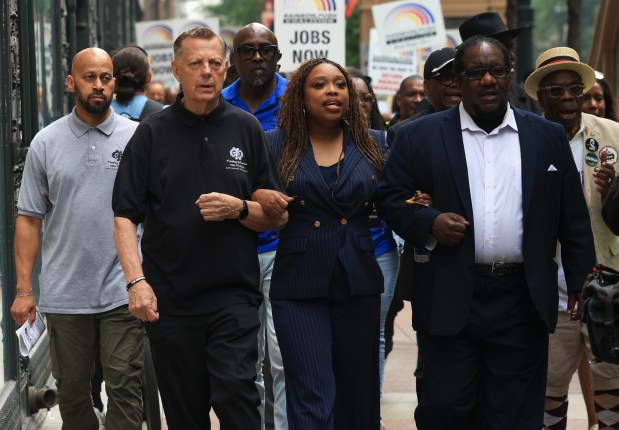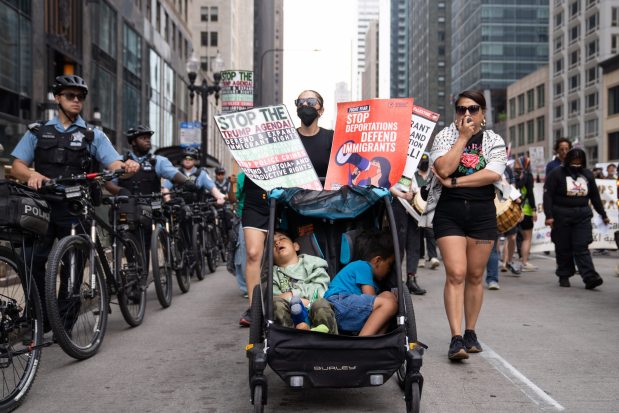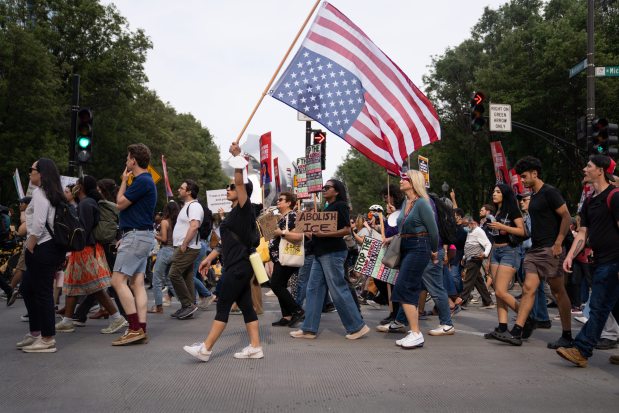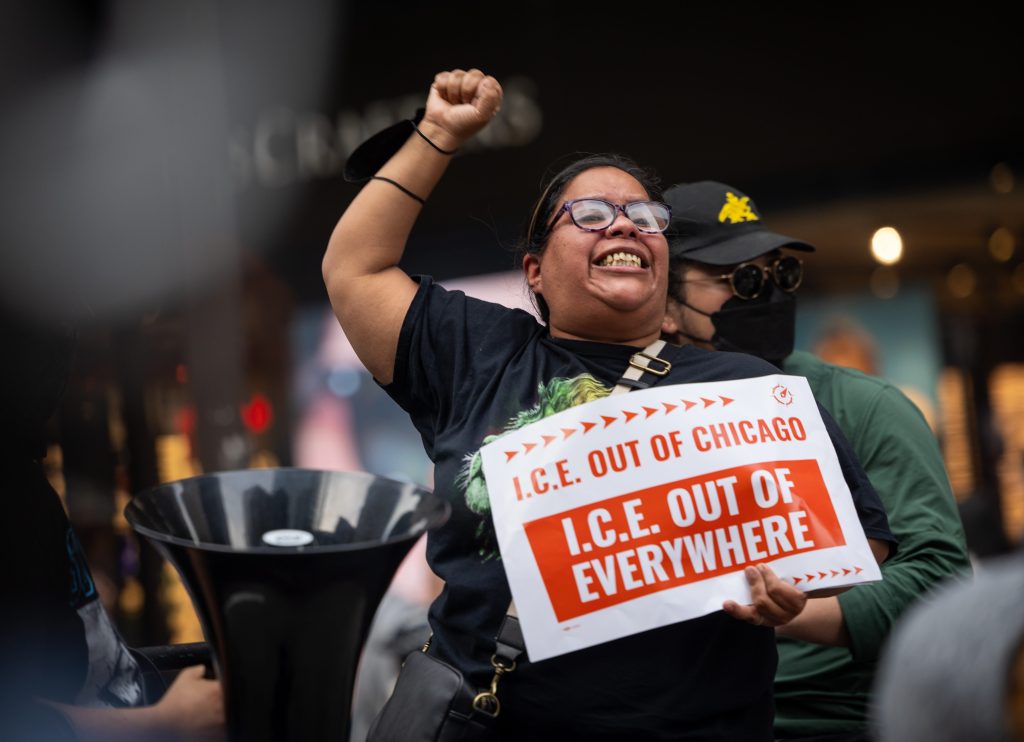Protests continued for another day Thursday in Chicago, part of the demonstrations across the country against President Donald Trump’s deployment of troops in Los Angeles amid his immigration crackdown.
The crowd at the day’s second protest grew to about 400 people by 4 p.m., as demonstrators held red signs and shouted their support for immigrants at Michigan Avenue and Ida B. Wells Drive.
“For months now the deportation machine has failed in Chicago because of our resistance,” said Muhammad Sankari of the Arab-American Action Network. “Trump forgot that Chicago fights back.”
An hour later, the group set out for Michigan Avenue, chanting, “Donald Trump, you’re a clown. Immigrants will take you down.”
Mayor Brandon Johnson, anticipating that the city may see further federal action in the coming days, called on Chicagoans Wednesday to “resist in this moment” if Trump mobilizes the military in Chicago to support ICE raids. Johnson’s chief of staff Cristina Pacione-Zayas told reporters that Chicago was expecting a blitz of enforcement by U.S. Immigration and Customs Enforcement at workplaces starting Thursday.
Advocates and activists reported several sets of arrests around the city Thursday, including at immigration court. At least two demonstrations took place downtown — one in the afternoon on South State Street and another outside an ICE outpost in the South Loop.
“People are joined together. … We will be marching to demand a stop to the raids and protection for our families,” said Lawrence Benito, executive director for Illinois Coalition for Immigrant Refugee Rights, at a morning news conference ahead of the protests.
In the first of the two protests, approximately 100 activists, including the Rev. Jesse Jackson and the Rev. Michael Pfleger, marched outside the Target store at the intersection of State and Madison streets to condemn the retail company’s recent policy reversals around diversity and “escalating civil rights rollbacks.”
Speakers condemned immigration enforcement that has swept up people, including children, at workplaces, court and in the street across the country.
“America doing the electric slide backward,” said Pastor Jamal Bryant, who likened the scene on State Street to a Woolworth’s lunch counter in the Civil Rights Movement. “This is the America we thought we changed.”
 The Rev. Michael Pfleger, front left, the Rev. Ciera Bates-Chamberlain, center, and the Rev. Marshall Hatch lock arms as they march June 12, 2025, outside a Target store at 1 S. State St. in Chicago to protest the company’s policy to scale back workforce diversity. (John J. Kim/Chicago Tribune)
The Rev. Michael Pfleger, front left, the Rev. Ciera Bates-Chamberlain, center, and the Rev. Marshall Hatch lock arms as they march June 12, 2025, outside a Target store at 1 S. State St. in Chicago to protest the company’s policy to scale back workforce diversity. (John J. Kim/Chicago Tribune)
By 4 p.m. protesters from the first rally began dashing to the second demonstration, organized by the Illinois Coalition for Immigrant and Refugee Rights.
“Nowadays, you have to choose between whether you want to get your medication and whether you want to pay your rent,” said Margaret Heywood-Smith, 70, as she hurried south down State Street.
The Chicago Housing Authority office at 60 E. Van Buren St. closed early Thursday due to the protests downtown, a CHA employee told the Tribune. Chicago’s immigration court also closed early, according to a post on X by the U.S. Department of Justice.
The wave of protests that began Friday in Los Angeles has spread to other cities including New York, Austin, Seattle and Las Vegas. Chicago saw its first large-scale demonstration Tuesday evening, when thousands marched through the Loop and beyond to demand that the federal government stand down on its arrests of undocumented immigrants. The demonstration spanned much of the Loop and River North neighborhoods and periodically snarled traffic on several crowded thoroughfares, including DuSable Lake Shore Drive.
Chicago police said 17 people were arrested at that protest, and four were charged with felonies. More a dozen people were charged or cited for defacing public property including squad cars and CTA buses, police said. But that tension still pales in comparison with California and Texas, where National Guard troops have mobilized at the direction of Trump and Texas Gov. Greg Abbott.
Johnson, Gov. JB Pritzker and Cook County Board President Toni Preckwinkle, all Democrats, are all vocal supporters of the “sanctuary city” status of Illinois and Chicago — meaning the city and state do not cooperate with federal immigration enforcement — Johnson said Wednesday that they were committed to “maintain the sensibilities of our democracy, the ability to freely express protest, that’s fundamental to our democracy.”
 Santi Brito-Lucero, 4, and Remy Brito-Lucero, 7, sleep as hundreds march down Michigan Avenue towards Trump Tower in Chicago on June 12, 2025, while protesting nationwide immigration raids by federal law enforcement and ICE. (Audrey Richardson/Chicago Tribune)
Santi Brito-Lucero, 4, and Remy Brito-Lucero, 7, sleep as hundreds march down Michigan Avenue towards Trump Tower in Chicago on June 12, 2025, while protesting nationwide immigration raids by federal law enforcement and ICE. (Audrey Richardson/Chicago Tribune)
 Hundreds march down Michigan Avenue to Trump Tower in Chicago on June 12, 2025, while protesting nationwide immigration raids by federal law enforcement and ICE. (Audrey Richardson/Chicago Tribune)
Hundreds march down Michigan Avenue to Trump Tower in Chicago on June 12, 2025, while protesting nationwide immigration raids by federal law enforcement and ICE. (Audrey Richardson/Chicago Tribune)
Speaking before a House committee on Thursday, Pritzker defended Illinois’ sanctuary laws for immigrants in the U.S. without legal permission.
“The vast majority of immigrants contribute to our communities, pay taxes and abide by the law. We should value their entrepreneurship, ingenuity and hard work. Both political parties are to blame for America’s broken immigration system. I hope that this committee chooses (to) be part of the solution by pursuing bipartisan comprehensive federal immigration reform,” the state’s two-term governor said in remarks submitted to the House Oversight and Government Reform Committee.
Andrew Herrera, a spokesperson for the Chicago Workers Collaborative, said the modern sanctuary city movement grew out of ICE raids at workplaces in the 2000s, when the public targeting of undocumented workers at meatpacking plants and industrial centers revealed how deeply disruptive federal immigration enforcement could be.
The movement gained momentum after high-profile raids in 2006 and 2008 under then-President George W. Bush, including the raids at Swift & Co. meatpacking plants in several Midwestern states and a meat-processing plant in Postville, Iowa, which led to hundreds of arrests and devastated entire communities.
If you’re arrested by ICE in Illinois, what happens next? Legal experts explain the process.
Over the past week, advocates have reported workplace raids across the suburbs. It’s unclear how many people have been swept up.
“The reports of weekend raids in the Chicago area don’t compare in scale, but it’s a significant escalation to do a workplace raid at all,” Herrera said.
Marco Ceniceros, executive director of Warehouse Workers for Justice, said the organization is bracing for more raids in the coming days, similar to what has been happening in Los Angeles.
“Immigrant workers are under attack everywhere. This administration and ICE are trying to intimidate, silence and kidnap many of the workers — the many people that make this economy run,” he said.
Since January, the organization responds at least “a couple times a day to sighting or rumors” that ICE is at workplaces. The workers, he said, have worked through the pandemic, extreme weather, pay taxes and keep communities going.
“They’re scared to drive to work, to drop off their kids at school, to go to church,” he said.
Activists have also announced plans for a “No Kings” march Saturday in concert with other demonstrations around the country, expected to draw thousands of people downtown.
Chicago Tribune’s Lizzie Kane contributed.
Originally Published: June 12, 2025 at 5:07 PM CDT
